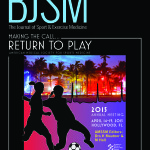By @Peter_Gettings
 I’m a Physiotherapist and I divide my time between Rheumatology and MSK patients. Here I share my experience of learning and using musculoskeletal ultrasound in my clinic. I have worked in private clinics, private hospitals, an EPL football academy and a professional cricket team — now I work exclusively within the NHS.
I’m a Physiotherapist and I divide my time between Rheumatology and MSK patients. Here I share my experience of learning and using musculoskeletal ultrasound in my clinic. I have worked in private clinics, private hospitals, an EPL football academy and a professional cricket team — now I work exclusively within the NHS.
How can you get started?
I attended the an introductory course on diagnostic ultrasound but still wanted more. I then undertook further training as an MSK sonographer, and that is where I am as I write, just about to hand in my portfolio for final marking.
In the UK, the profession of Sonographer is not recognised by Health and Care Professions Council (HCPC). There are no legal requirements to use ultrasound in practice. It is actually quite easy (some might argue too easy) to get started. There are plenty of short courses that will teach you the basics of scanning, giving you the minimum you need to pick up and use a scanner. A good option is a weekend course that provides enough teaching and scanning time to allow you to get going. An important point to consider is that some courses are more clinically focussed than others. Before parting with your hard earned cash, research the tutors’ credentials and if the course comes with recognised CPD accreditation (eg from the Royal College of Radiologists/European Society of Musculoskeletal Radiology).
Progressing from the basics
There is a steep learning curve to MSKUS. It takes a significant investment of time to improve once you have learned the basic skills of probe handling and image interpretation. Aim to work with someone as a mentor who can continue to teach and challenge you once you get started.
The hardest thing for me was gaining confidence in my own scanning ability and reporting on the clinical relevance of what I see. It is so easy to see something abnormal on a scan and assume it’s the cause of the symptoms. As a physiotherapist, US is incredibly useful as an integrated part of my every day practice. I don’t scan every patient I see. I am a big believer that if the scan is unlikely to have a direct impact on the management of the patient then it is not worth doing. However, having the ability in clinic to carry out a diagnostic scan that will offer important information to assist clinical decision making is a huge bonus.
Practice based lessons
One of the biggest lessons that I have learned from scanning is that there is often little correlation between the degree of abnormality seen on a scan and the severity of patients’ symptoms. It is really useful to show patients ‘abnormal pathology’ on both their painful and pain-free side to get them on board with rehab. I have been scanning for three years and am still learning!
Physiotherapists are ideally placed to make good use of US. We are well-trained and experienced in musculoskeletal examination, so we take a thorough history from patients, carry out a skilled physical exam and then use this information to formulate a diagnosis and treatment plan. This combination of skills gives us an edge when it comes to the use of US; the scan should always be interpreted in relation to the patient and their history.
A big advantage of MSKUS is that you can view structures dynamically rather than just statically as is the case with X-ray and MRI. You can even scan while you are carrying out physical tests. It is often the correlation between the history, imaging and talking to the patient while scanning that will give the most useful information. I have had cases where US has picked up findings, such as fractures or the presence of foreign bodies, that have been missed on other imaging. Thus, the use US scan has directly improved the management of the patient.
If you are interested in starting to use MSK ultrasound, I have written a short piece here on points to consider when purchasing a scanner and I would highly recommend checking out http://theultrasoundsite.co.uk for a wealth of further information.
You can find me on Twittert (@Peter_Gettings) -feel free to send me questions or suggestions for BJSM’s ultrasound focus. In 2015, BJSM issue #3 will be focused on Ultrasound. It will go live on Friday January 16 but there are already many interesting papers up Online First. Here’s a sneak peek of the cover. Click (1) here for an Online First paper on broader us of US in sports medicine beyond MSK and (2) here for one reviewing the role of US in detecting fractures.
PS: I you have read all the way to here you deserve a gift…shhh! Don’t tell anyone else – you can download the BJSM mobile app for FREE!! #SecretSanta
Peter Gettings is a musculoskeletal Physiotherapist working in the NHS for a Foundation Trust in Essex. He works within the physiotherapy and rheumatology departments. He also works in the radiology department covering an MSK ultrasound list while working towards his PGCert in MSK ultrasound.
